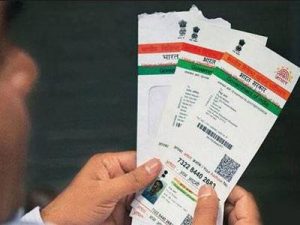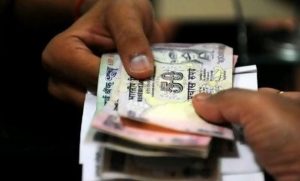News For Aspirants
UIDAI allows face recognition

The UIDAI on 28 January 2018 allowed face recognition as additional means of Aadhaar authentication to be used in combination with existing ways such as fingerprint or iris scan.
The move will enable easy authentication for those individuals who face a difficulty in other biometric authentication like fingerprint and iris. The facility is being allowed only in a “fusion mode” that is along with other existing means of authentication, and will be available by July 1, 2018.
What
- This facility is going to help in inclusive authentication of those who are not able to biometrically authenticatedue to their worn out fingerprints, old age or hard work conditions.
- As of now, two modes of biometric authentication, fingerprint authentication and iris authentication, are allowed under Aadhaar.
- The face authentication provides additional option for all residents to have inclusive authentication. It shall be allowed only in fusion mode along with one more authentication factor combined with either fingerprint or iris or OTP to be able to successfully authenticate an Aadhaar number holder. The new method will also be allowed “on need basis”.
- This move comes close on the heels of the biggest overhaul of Aadhaar system by the UIDAIlast week when it allowed individuals to create and use a virtual ID to avoid sharing their unique identity numbers, when using government and other services.
- Users will, from March 1, have the option of generating a 16-digit virtual identity mapped to their Aadhaar numberthat can be shared with telecom companies and others at the time of authenticating their identity.
- From June 1, 2018, it will be compulsory for all agencies, which undertake authentication, to accept the virtual IDs from their users.
- As many as 119 crore biometric identifiers have been issued so far, and Aadhaar is required as an identity proof of residents by various government and non-government entities.
- For instance, the government has made it mandatory for verifying bank accounts and PAN to weed out black money and bring unaccounted wealth to book.
- The same for SIM cards has been mandated to establish the identity of mobile phone users.
News For Aspirants
India ranked second in cheaper to live

India is ranked second only to South Africa as the cheapest country to live or retire, according to a recent survey of 112 countries. The survey by GoBankingRates ranked nations on the bases of four key affordability metrics provided by online pricing database Numbeo.
The metrics are: Local purchasing power index, rent index, Groceries index, and Consumer price index.
What
- With the second lowest rent indexamong the 50 cheapest countries (after neighbour Nepal), living in India can be cheaper compared to most of the countries.
- India also has some of the lowest prices for consumer goods and groceries, with typical monthly expenses for these priced around $285 for a single person living in Kolkata.
- The survey says that India, home to 1.25 billion residents, is the most populous among the 50 cheapest countries. Its major industries include textiles, chemicals and food processing. India also has a relatively high local purchasing power in the major cities that were surveyed.
- India’s local purchasing power is 20.9 per cent lower, rent is 95.2 per cent cheaper, groceries are 74.4 per cent cheaper, local goods and services are 74.9 per cent cheaper.
- India is cheaper than countries like Colombia ranked at 13, Pakistan (14), Nepal (28), Bangladesh (40).
- The local purchasing power index measures the relative purchasing power of a typical salary in that country, compared to New York City. A lower purchasing power buys fewer goods, while a higher purchasing power buys more.
- While the rent index compares typical rental prices in the country to New York City, the groceries index holds a similar comparison for typical grocery prices.
- The consumer price index compares costs of local goods and services – including restaurants, groceries, transportation and utilities to New York City.
- According to the survey, even among the 50 cheapest countries, rent is at least 70 per cent cheaper than in New York City, groceries are at least 40 per cent cheaper, and consumer goods and services cost less by 30 per cent or more.
- South Africa has topped the survey as the cheapest country to live or retire. Being the world’s largest producer of platinum, gold and chromium, goes far to enrich the country and its economy. This resulted in a local purchasing power that is significantly higher than what New Yorkers face, which is the most favourable factor that helps South Africa top the list.
- Along with a higher local purchasing power, South Africa also offers lower prices on consumer goods and groceries, and rent costs that are typical of the 50 cheapest countries. In the major city of Cape Town, for instance, monthly expenses total just under USD 400 while the average rent costs are reflected by the typical price to rent a one-bedroom in Durban of around USD 280 a month.
- Among the most expensive countries in the survey are Bermuda (ranked 112), Bahamas (111), Hong Kong (110), Switzerland (109) and Ghana (108).
News For Aspirants
More amendments in insolvency law

The insolvency law might be amended depending on recommendations of the panel reviewing issues related to the legislation, including those pertaining to home buyers, a senior government official said.
While everything is time-bound under the Insolvency and Bankruptcy Code (IBC), Corporate Affairs Secretary Injeti Srinivas said the issue is how the interests of stakeholders are to be balanced. A 14-member panel, also chaired by Srinivas, is working to identify and suggest ways to address issues faced in the implementation of the IBC, which came into force in December 2016.
What
- There is a feeling that this law is skewed a little too much in favour of financial creditors. It is not adequately addressing the requirements or expectations of other stakeholders. It is a serious area we have to look at. The committee is looking at all the issues.
- According to him, competition, regulatory clearances, tax liabilities and other aspects would also be looked at. It was felt that there was enough reason to have a comprehensive stock taking even though it is a one-year old law… Based on recommendations of the Insolvency Law Committee, in the future there may be changes in the IBC.
- A large number of cases have been filed under the IBC, which provides for a market-determined and time-bound insolvency resolution process. There are also apprehensions on whether this system (insolvency law) can be abused. Can somebody trigger this system for some sort of wrongful intent?
- Among others, issues such as whether the insolvency process should be governed by liquidationvalue or enterprise value would also be looked into. “What are the rights of home buyers? What is the capacity of insolvency professionals? These are among the issues that has to be seen.
- In recent months, there have been concerns about incomplete realty projects and consequent hardships faced by home buyers. Some real estate firms are also facing insolvency proceedings. There have also been suggestions from certain quarters about having provisions that would help provide relief to home buyers.
- The panel members include Insolvency and Bankruptcy Board of India (IBBI)Chairperson M S Sahoo, RBI Executive Director Sudarshan Sen, former Lok Sabha Secretary General T K Viswanathan, Edelweiss Group Chairman and CEO Rashesh Shah, Shardul Amarchand Mangaldas and Co Executive Chairman Shardul Shroff and Xpro India Chairman Sidharth Birla.
- Earlier this month, Parliament cleared amendments to the IBC that would prevent unscrupulous persons from misusing the law. Wilful defaulters and those whose accounts have been classified as non-performing assets, among others, are barred from bidding for stressed assets under the IBC.
News For Aspirants
Hindi word of 2017

Oxford Dictionaries has chosen ‘Aadhaar’ as the Hindi word of 2017. The word gained popularity due to Aadhaar card, which was in news last year and is likely to remain in highlight this year as well. The announcement was made at a session “Oxford Dictionaries’ Hindi Word of the Year” during the ongoing Jaipur Literature Festival.
What
- Other words such as ‘Mitron’, ‘Notebandi’, ‘Gau-Rakshak’were also considered, but the widespread discussions and debates around ‘Aadhaar’ was the reason it was selected as the word of the year.
- New words like ‘Sleepawastha’ (state of sleeping), ‘Maukatarian’ (opportunist)should be coined to express certain moods. Chitra Mudgal objected to the suggestion and instead advocated for the correct use of languages.
- If a person with lack of proper knowledge coins and expresses such words then it can be understood but this is not acceptable when educated people do this.
- Poet and writer Ashok Vajpeyi said politicians use Hindi word ‘Mitron’ (friends) which is not grammatically correct, when in fact the correct word is ‘Mitro’ — an apparent reference to Prime Minister Narendra Modi who uses the term often in his speeches.


